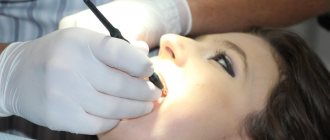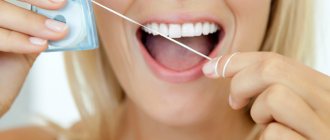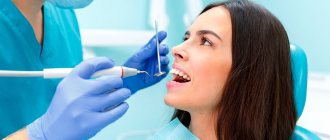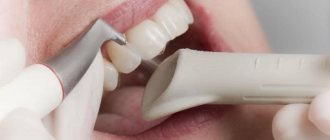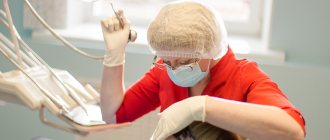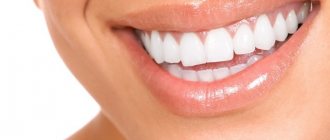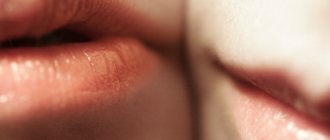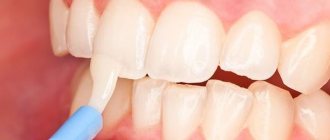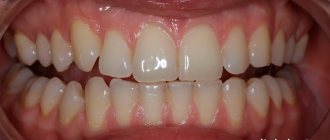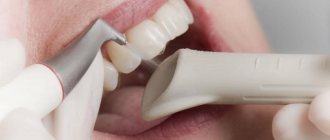Professional hygienic cleaning of teeth and oral cavity at the dentist - what is it, how is such a procedure carried out? Doctors recommend using this method once every six months. During one visit to the dental office, a whole range of measures is carried out: plaque and hard deposits (stone) are removed, inflammatory diseases are prevented, and the general condition of the dentition is improved.
Currently, there are several methods of cleansing, which include laser, ultrasound, and the modern “Air Flow” technique. Carrying out a hygienic procedure in dentistry has many advantages and is popular among patients.
What it is?
Professional teeth cleaning means removing hard and soft plaque from teeth, as well as polishing them. Therefore, the procedure usually consists of two parts, and various methods can be used to remove the stone, for example:
- mechanical;
- ultrasonic;
- laser:
- sandblasting (Air Flow);
- using the VECTOR device.
In serious cases, the dentist may use a combination of several methods. Most often, ultrasonic cleaning is done, and then for final polishing, Air Flow is used.
In addition to caring for your teeth, professional cleaning takes care of the condition of your fillings and polishes the filling material. This allows you to preserve the original color of the filling and prevent its destruction.
During the manipulation process, the dentist performs a hardware removal of all excess from the tooth enamel and removes particles from the oral cavity. At the end, a protective fluoride varnish is applied, which reduces tooth sensitivity and contributes to the long-term preservation of the light tone of the enamel and the smoothness of each tooth.
Choosing toothpaste
To brush your teeth properly, you need to take a responsible approach to choosing toothpaste. It is necessary to select a product taking into account the condition of the oral cavity. Not all products are suitable for sensitive teeth. For people who suffer from rapid plaque formation, an antibacterial paste will be needed. Those who have increased gum bleeding will need to purchase a special medicated paste. To make the cleansing process comfortable and effective, it is better to give preference to products from well-known brands that have long proven themselves in the market. Before you buy a whitening paste, you need to know that such products mainly contain special enzymes that quickly remove plaque. Dentists do not recommend using whitening pastes for more than two months.
You should remember a simple rule: too much product reduces the effect of brushing. For one procedure, a pea-sized amount of paste should be enough.
Should I brush my teeth?
The question of whether it is worth having professional teeth cleaning or using home remedies may be of interest to almost every person. To understand the need for such a procedure, you should know how plaque is formed.
Even if you carefully follow your dentist’s recommendations and brush your teeth regularly, ideally after every meal, using a toothbrush and the best toothpaste can only remove soft plaque. And even with the correct movements and careful work of the brush, there may be hard-to-reach places in the dentition where, in a short period of time, plaque is mineralized by calcium salts, which are contained in human saliva. As a result, hard plaque (tartar) forms, which cannot be removed at home.
Tartar is made up of bacteria that cause serious dental disease and can lead to the loss of one or more teeth. In addition, the stone is dark in color, so teeth lose their natural whiteness with plaque.
The peculiarity of the formation of tartar is that as soon as the first film appears on the teeth, the process accelerates significantly. The surface of the tooth enamel becomes rough, so various microorganisms easily stick to it. In addition to losing a beautiful appearance, a person develops bad breath.
To get rid of tartar and restore natural whiteness, you need to have your teeth cleaned in a clinic. Only a specialist with dental equipment can effectively remove plaque and tartar, polish and subsequently care for teeth.
Cleaning with thread
After regular brushing, it is necessary to treat the space between the teeth. The brush does not always cope with this task, and therefore plaque and various microorganisms collect in them. In order to clean the areas, you need to use thread. So, using sawing movements, the thread is inserted into the space between the teeth. Next, it picks up dirt and removes it. You need to be careful with this device, as there is a possibility of damaging your gums.
Photo: Dental floss (floss) is a special thread for cleaning interdental spaces.
How often should I clean?
Dentists have a unanimous opinion on the issue of frequency of teeth cleaning. The procedure should be performed 1-2 times a year, but not more often, so as not to damage the enamel.
It is necessary to take into account the individual characteristics of the body - for some it is enough to clean the stone once a year, while for another person plaque formation occurs faster, and he needs to visit the dental clinic once every six months.
In addition, professional teeth cleaning is indicated before prosthetics, implantation and dental treatment, as well as before teeth whitening. A clean tooth surface will allow the dentist to do his job better:
- better choose the color of the filling, crown or veneer;
- notice the onset of caries in time;
- prevent many gum diseases;
- achieve good treatment and whitening results.
This manipulation is recommended for those people who smoke and often drink drinks with dyes (tea, coffee, wine, etc.).
Cleaning methods
Currently, dentists offer several methods for cleaning teeth. The oldest is mechanical, when tartar is destroyed using a special tool in the form of hooks. This method can injure your gums, so it is rarely used.
One of the progressive methods is ultrasound. Cleansing is carried out using an ultrasonic scaler. Stones are destroyed by sound vibrations of a certain frequency, while plaque is removed and supragingival and subgingival pockets are cleaned. The doctor can use attachments of different sizes, depending on the complexity of the treatment area and the thickness of the plaque. In addition, during the work, water or an antiseptic is supplied to the oral cavity, which removes stone particles through a dental saliva ejector. The patient does not feel pain, but if the necks of the teeth are sensitive, the doctor administers local anesthesia.
Modern laser systems allow not only to remove the hardest tartar, but also to whiten teeth. The device causes the evaporation of moisture contained in plaque and removes deposits from the enamel in layers. At the same time, the enamel receives a lighter shade, and the achieved result of a snow-white smile will last for several years. The procedure is absolutely painless, but for certain categories of patients there are contraindications.
The latest Swiss technology Air Flow makes it possible to remove particles of plaque, stone and pigments in hard-to-reach places, clean subgingival pockets and polish enamel. Treatment is carried out with a jet of cleaning mixture, which consists of sodium bicarbonate and water. Under high pressure, this composition is applied to each tooth. Regular baking soda acts as an abrasive. This sandblasting method allows for high-quality hygienic treatment, removing all excess from the teeth, achieving a smooth surface of the tooth enamel and its natural lightening. The manipulation is painless and pleasant for the patient. The result is a Hollywood smile and clean teeth.
The VECTOR device is the latest word in dentistry. It is intended for the prevention and treatment of periodontitis and acts by vibration. This technique takes advantage of ultrasonic waves and the active action of a fluoride and calcium based cleaning mixture. Using such equipment, the doctor removes deposits and bacteria, cleans subgingival pockets and polishes tooth enamel.
Modern people have a wide choice of professional hygiene methods. A consultation with a dentist will help you choose the most suitable one.
The fourth stage - fluoridation
As a rule, fluoridation is not included in the calculation of comprehensive professional hygiene, but it is very important for dental health. The application of fluoride helps strengthen the enamel layer (prevents the leaching of calcium), reduces hypersensitivity, prevents the onset of caries (slows down the proliferation of pathogenic bacteria). Therefore, you should not refuse this procedure. Fluoridation algorithm: the doctor dries the surface to be treated with a warm air stream, then applies fluoride varnish (a harmless composition based on varnish with a high concentration of fluorides) to each element of the dentition, then dries it.
Note: after completing all stages of comprehensive cleansing, teeth become noticeably lighter, reaching their natural natural color. But those patients who dream of a snow-white smile can resort to whitening, for example, using the ZOOM-4 method.
Indications and contraindications
Teeth cleaning in a dental clinic is recommended for everyone, but those people who:
- have installed permanent dental structures (braces, veneers, crowns, implants, etc.);
- are going to undergo professional teeth whitening;
- planning prosthetics or dental treatment;
- smoke;
- drink a lot of drinks that have a coloring effect (coffee, tea, etc.).
If there are certain health problems, a person cannot use any of the teeth cleaning methods offered by dentists, but if necessary, you can choose another option. For example, temporary contraindications include:
- inflammation of the oral mucosa;
- ARVI, bronchitis or other diseases that make nasal breathing difficult;
- pregnancy and breastfeeding period.
In such cases, professional teeth cleaning can be done after such reasons have ended.
General contraindications include the following health problems:
- arrhythmia and other heart diseases;
- asthma;
- increased sensitivity of teeth;
- allergic reactions;
- tuberculosis;
- hepatitis;
- various infectious diseases;
- epilepsy, etc.
Such manipulations are not performed on children and adolescents; if necessary, stone cleaning can be carried out if permanent teeth are present (over the age of 12 years).
What not to do after prof. cleaning?
When a person has spent time and money, visited a dentist and received an excellent result in the form of clean teeth and a snow-white smile, the desire to preserve all this for a longer time becomes understandable. Therefore, it is important to follow the following general recommendations:
- do not eat or drink (especially drinks with dyes) for 2 hours after the procedure;
- Replace an old toothbrush that contains bacteria with a new one;
- for 7 days, eat less foods that can stain tooth enamel (coffee, wine, tea, etc.);
- rinse your mouth after every meal;
- regularly brush your teeth with the correct movements, use special threads;
- Go to the dentist once every six months.
Third stage - polishing
Deposits leave microcracks and irregularities on the enamel layer. Therefore, polishing is necessary after cleaning procedures. Otherwise, the remaining roughness will become a “magnet” for microparticles of food, which will very quickly turn into new deposits. Polishing is performed using abrasive pastes and various attachments driven by a drill. These are polishers, brushes, discs, needle-shaped attachments. The interdental areas are polished with special strips. The process does not cause pain and takes about 40 minutes.
